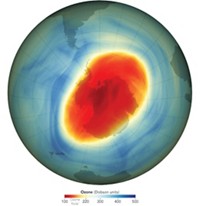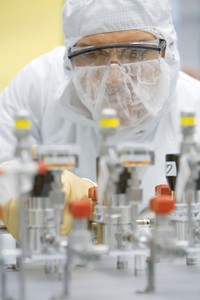Advertisement
Grab your lab coat. Let's get started
Welcome!
Welcome!
Create an account below to get 6 C&EN articles per month, receive newsletters and more - all free.
It seems this is your first time logging in online. Please enter the following information to continue.
As an ACS member you automatically get access to this site. All we need is few more details to create your reading experience.
Not you? Sign in with a different account.
Not you? Sign in with a different account.
ERROR 1
ERROR 1
ERROR 2
ERROR 2
ERROR 2
ERROR 2
ERROR 2
Password and Confirm password must match.
If you have an ACS member number, please enter it here so we can link this account to your membership. (optional)
ERROR 2
ACS values your privacy. By submitting your information, you are gaining access to C&EN and subscribing to our weekly newsletter. We use the information you provide to make your reading experience better, and we will never sell your data to third party members.
Environment
Questioning NF3
Scientists seek measurements of electronic chemical in atmosphere
by Melody Voith
July 14, 2008
| A version of this story appeared in
Volume 86, Issue 28

INCREASING DEMAND for electronic products, including flat-panel displays, has triggered concern among atmospheric scientists over emissions of nitrogen trifluoride, a potent greenhouse gas.
In electronics manufacturing, NF3 is used to clean chambers used for chemical vapor deposition of key materials onto glass or a silicon wafer. Most, but not all, of the gas is destroyed in the process.
In a new paper, Michael J. Prather and Juno Hsu of the University of California, Irvine, write that "it is urgent to document NF3 emissions through atmospheric observations" because the gas has a life span of 550 years and its greenhouse effect is roughly 17,000 times as potent as CO2 (J. Geophys. Res. Lett. 2008, 35, L12810). The gas is not monitored under the Kyoto protocol but is included in the 2001 Intergovernmental Panel on Climate Change assessment. Prather, an atmospheric chemistry researcher, was the lead author of the IPCC assessment.
The gas was little used in 1996, when the Kyoto protocol was written, but demand for NF3 began to increase in 1999, when the semiconductor industry vowed to cut greenhouse gas emissions 10% by 2010. The NF3 process has been replacing older perfluorocarbon systems, commonly based on C2F6.
Although the greenhouse gas profiles of NF3 and C2F6 are similar, NF3 is significantly more efficient as a cleaning agent. With the 2F6 process, which is only 20–30% efficient, large quantities of the gas are released to the atmosphere.
Air Products & Chemicals, the leading manufacturer of NF3, is in the process of expanding global capacity to 3,000 metric tons per year to meet rising demand. Corning Painter, the firm's vice president of global electronics, agrees that atmospheric measurements should be taken but says "more than 20 years of research and work with our customers find that less than 2% of NF3 is released to the atmosphere." According to Painter, more than 98% of the gas is destroyed in the cleaning process and most of the rest by emission-control equipment.
Prather and Hsu estimate that 2008 production of NF3 will be about 4,000 metric tons. There are currently no measurements of how much NF3 is in the atmosphere.




Join the conversation
Contact the reporter
Submit a Letter to the Editor for publication
Engage with us on Twitter